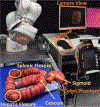Magnetic Levitation for Soft-Tethered Capsule Colonoscopy Actuated With a Single Permanent Magnet: A Dynamic Control Approach
- PMID: 31304240
- PMCID: PMC6625788
- DOI: 10.1109/LRA.2019.2894907
Magnetic Levitation for Soft-Tethered Capsule Colonoscopy Actuated With a Single Permanent Magnet: A Dynamic Control Approach
Abstract
The present letter investigates a novel control approach for magnetically driven soft-tethered capsules for colonoscopy-a potentially painless approach for colon inspection. The focus of this work is on a class of devices composed of a magnetic capsule endoscope actuated by a single external permanent magnet. Actuation is achieved by manipulating the external magnet with a serial manipulator, which in turn produces forces and torques on the internal magnetic capsule. We propose a control strategy which, counteracting gravity, achieves levitation of the capsule. This technique, based on a nonlinear backstepping approach, is able to limit contact with the colon walls, reducing friction, avoiding contact with internal folds, and facilitating the inspection of nonplanar cavities. The approach is validated on an experimental setup, which embodies a general scenario faced in colonoscopy. The experiments show that we can attain 19.5% of contact with the colon wall, compared to the almost 100% of previously proposed approaches. Moreover, we show that the control can be used to navigate the capsule through a more realistic environment-a colon phantom-with reasonable completion time.
Keywords: Medical robots and systems; force control; motion control.
Figures






Similar articles
-
Adaptive Dynamic Control for Magnetically Actuated Medical Robots.IEEE Robot Autom Lett. 2019 Oct;4(4):3633-3640. doi: 10.1109/LRA.2019.2928761. Epub 2019 Jul 15. IEEE Robot Autom Lett. 2019. PMID: 31406915 Free PMC article.
-
Explicit Model Predictive Control of a Magnetic Flexible Endoscope.IEEE Robot Autom Lett. 2019 Apr;4(2):716-723. doi: 10.1109/LRA.2019.2893418. Epub 2019 Jan 16. IEEE Robot Autom Lett. 2019. PMID: 30931392 Free PMC article.
-
Robotic-Assisted Colonoscopy Platform with a Magnetically-Actuated Soft-Tethered Capsule.Cancers (Basel). 2020 Sep 2;12(9):2485. doi: 10.3390/cancers12092485. Cancers (Basel). 2020. PMID: 32887238 Free PMC article.
-
Colon capsule endoscopy and its effectiveness in the diagnosis and management of colorectal neoplastic lesions.Expert Rev Anticancer Ther. 2019 Jan;19(1):71-80. doi: 10.1080/14737140.2019.1538798. Epub 2018 Oct 30. Expert Rev Anticancer Ther. 2019. PMID: 30354507 Review.
-
Magnetically guided capsule endoscopy.Med Phys. 2017 Aug;44(8):e91-e111. doi: 10.1002/mp.12299. Epub 2017 Jun 23. Med Phys. 2017. PMID: 28437000 Review.
Cited by
-
Development of Precision Controllable Magnetic Field-Assisted Platform for Micro Electrical Machining.Micromachines (Basel). 2024 Aug 1;15(8):1002. doi: 10.3390/mi15081002. Micromachines (Basel). 2024. PMID: 39203653 Free PMC article.
-
Endorobots for Colonoscopy: Design Challenges and Available Technologies.Front Robot AI. 2021 Jul 14;8:705454. doi: 10.3389/frobt.2021.705454. eCollection 2021. Front Robot AI. 2021. PMID: 34336938 Free PMC article. Review.
-
[Robots in the operating room-(co)operation during surgery].Gastroenterologe. 2021;16(1):25-34. doi: 10.1007/s11377-020-00496-x. Epub 2020 Dec 22. Gastroenterologe. 2021. PMID: 33362879 Free PMC article. Review. German.
-
Propulsion Mechanisms in Magnetic Microrobotics: From Single Microrobots to Swarms.Micromachines (Basel). 2025 Jan 31;16(2):181. doi: 10.3390/mi16020181. Micromachines (Basel). 2025. PMID: 40047696 Free PMC article. Review.
-
Optimal Motion Control of a Capsule Endoscope in the Stomach Utilizing a Magnetic Navigation System with Dual Permanent Magnets.Micromachines (Basel). 2024 Aug 14;15(8):1032. doi: 10.3390/mi15081032. Micromachines (Basel). 2024. PMID: 39203683 Free PMC article.
References
-
- Valdastri P et al., “ Wireless therapeutic endoscopic capsule: In vivo experiment,” Endoscopy, vol. 40, no. 12, pp. 979–982, December 2008. [Online]. Available: http://www.thieme-connect.de/DOI/DOI?10.1055/s-0028-1103424 - PubMed
-
- Mahoney AW and Abbott JJ, “Five-degree-of-freedom manipulation of an untethered magnetic device in fluid using a single permanent magnet with application in stomach capsule endoscopy,” Int. J. Robot. Res, vol. 35, no. 1–3, pp. 129–147, 2016.
-
- Chautems C and Nelson BJ, “The tethered magnet: Force and 5-DOF pose control for cardiac ablation,” in Proc. IEEE Int. Conf. Robot. Automat., 2017, pp. 4837–4842.
Grants and funding
LinkOut - more resources
Full Text Sources
